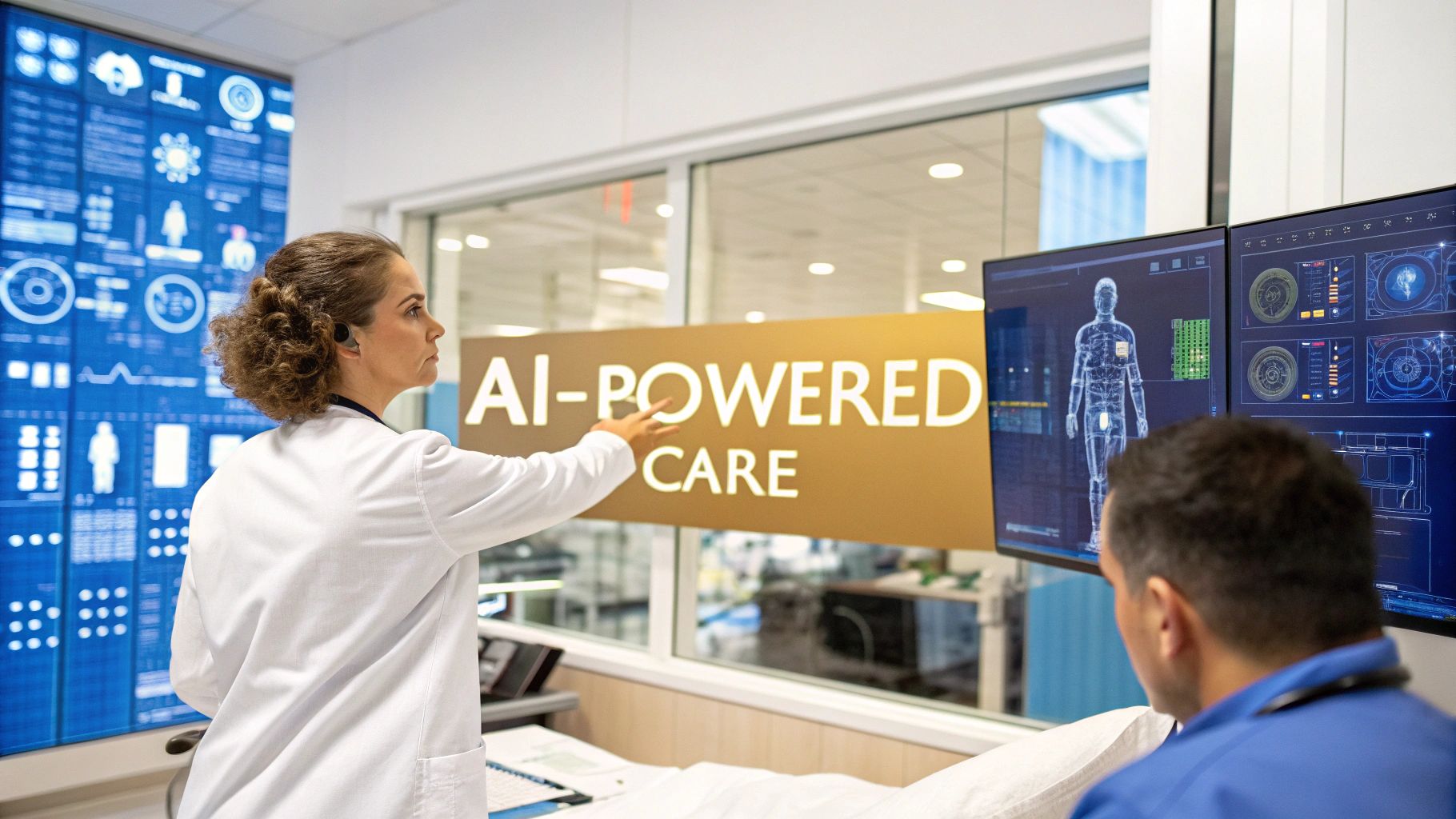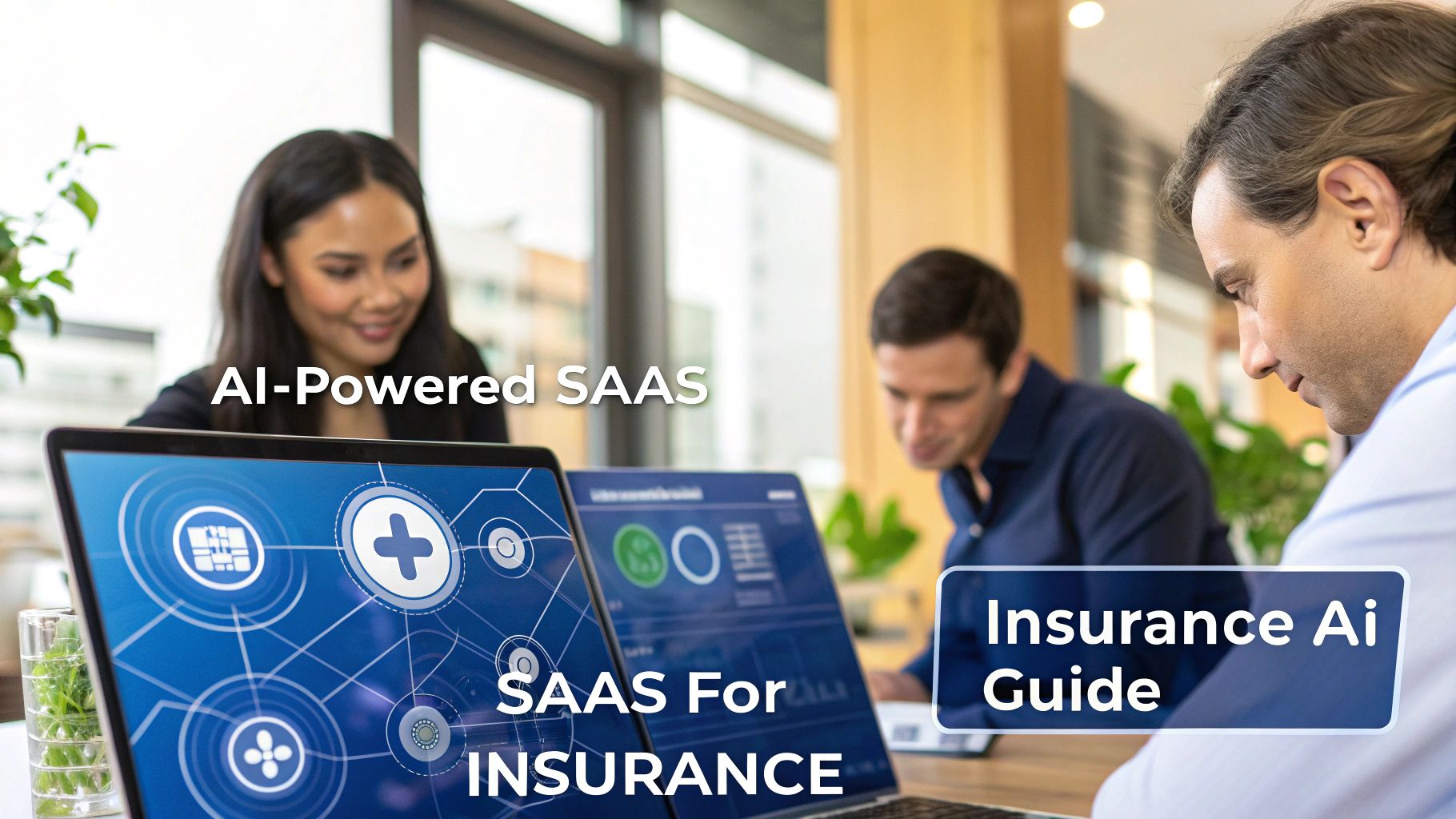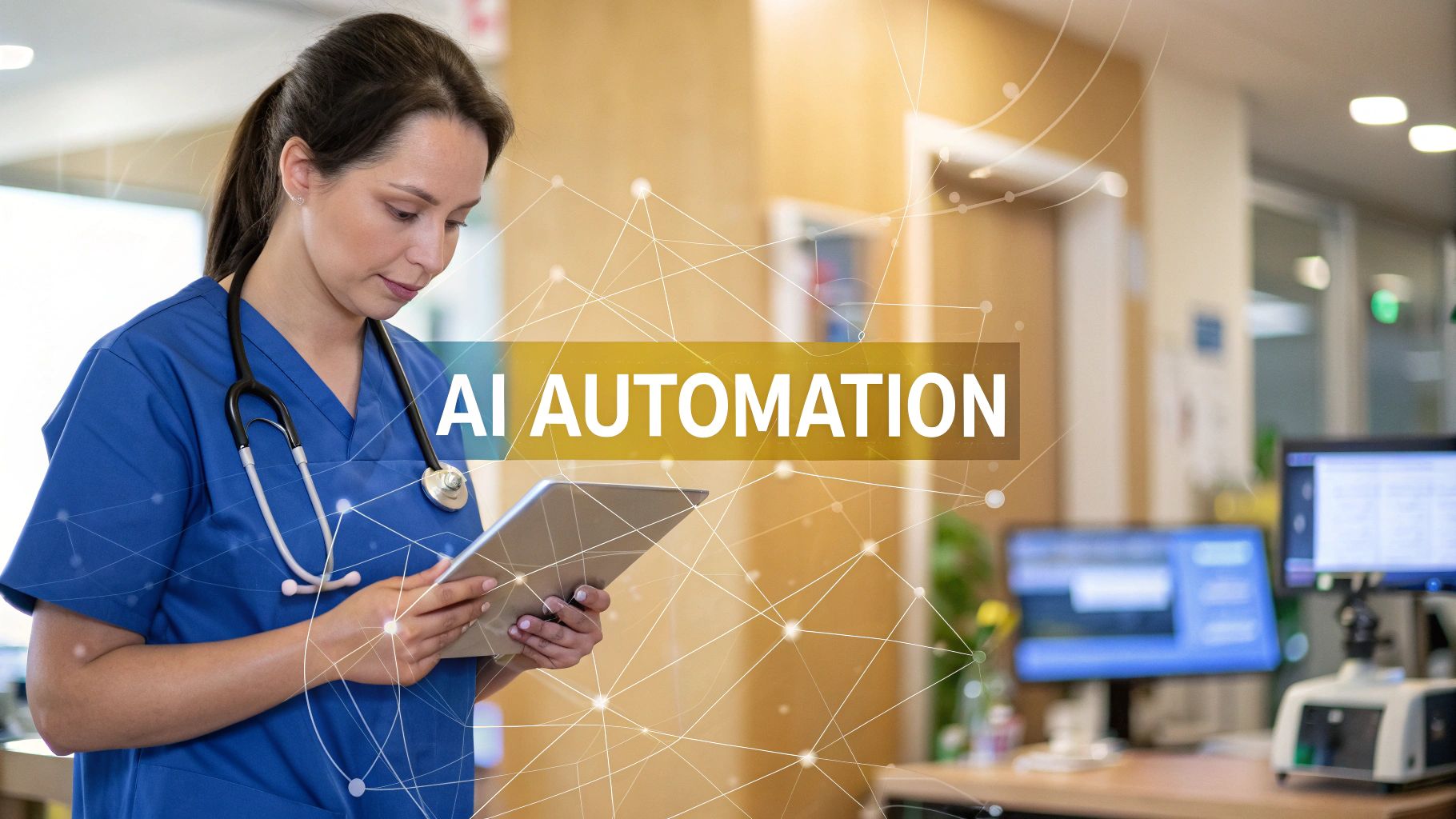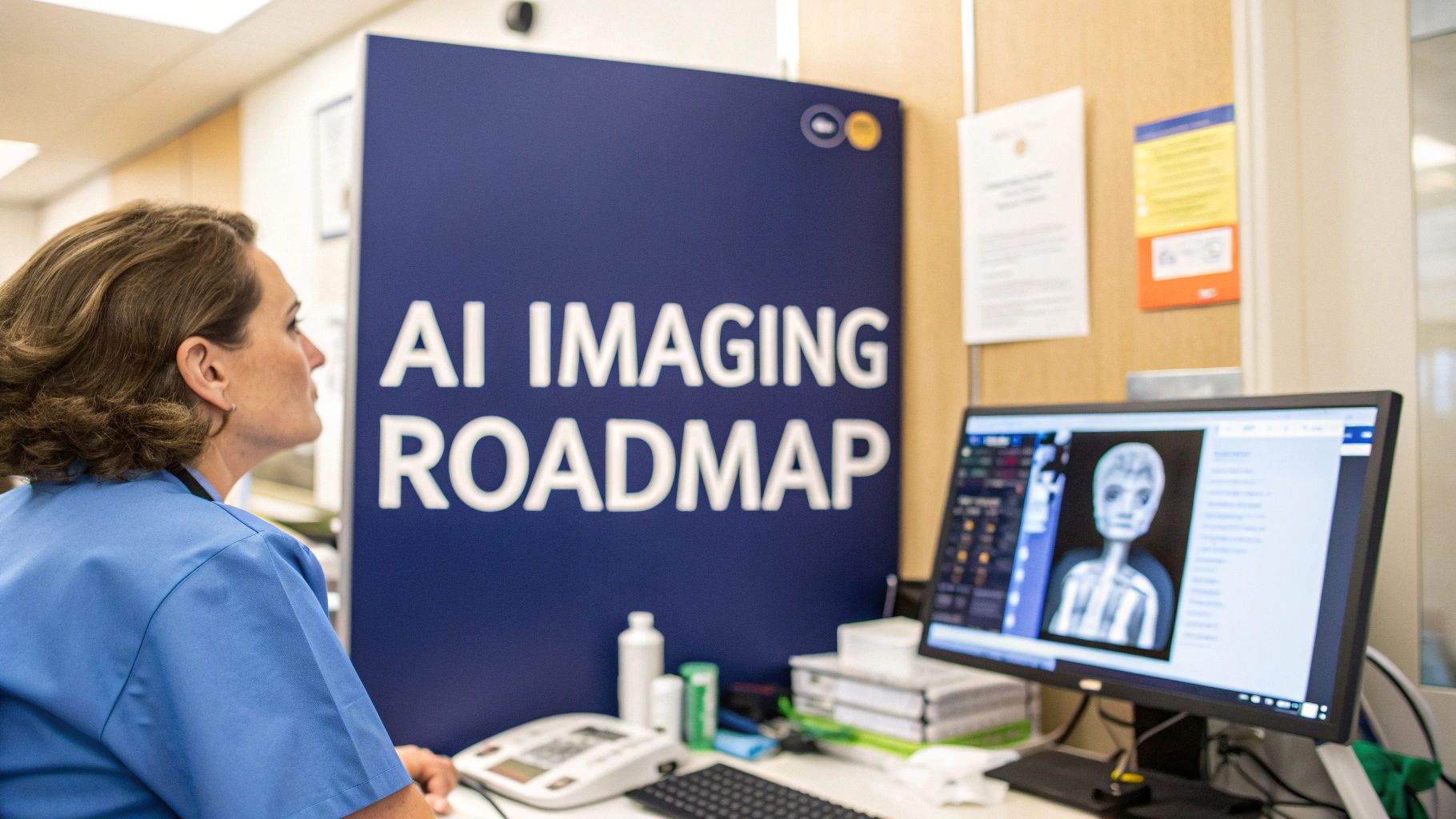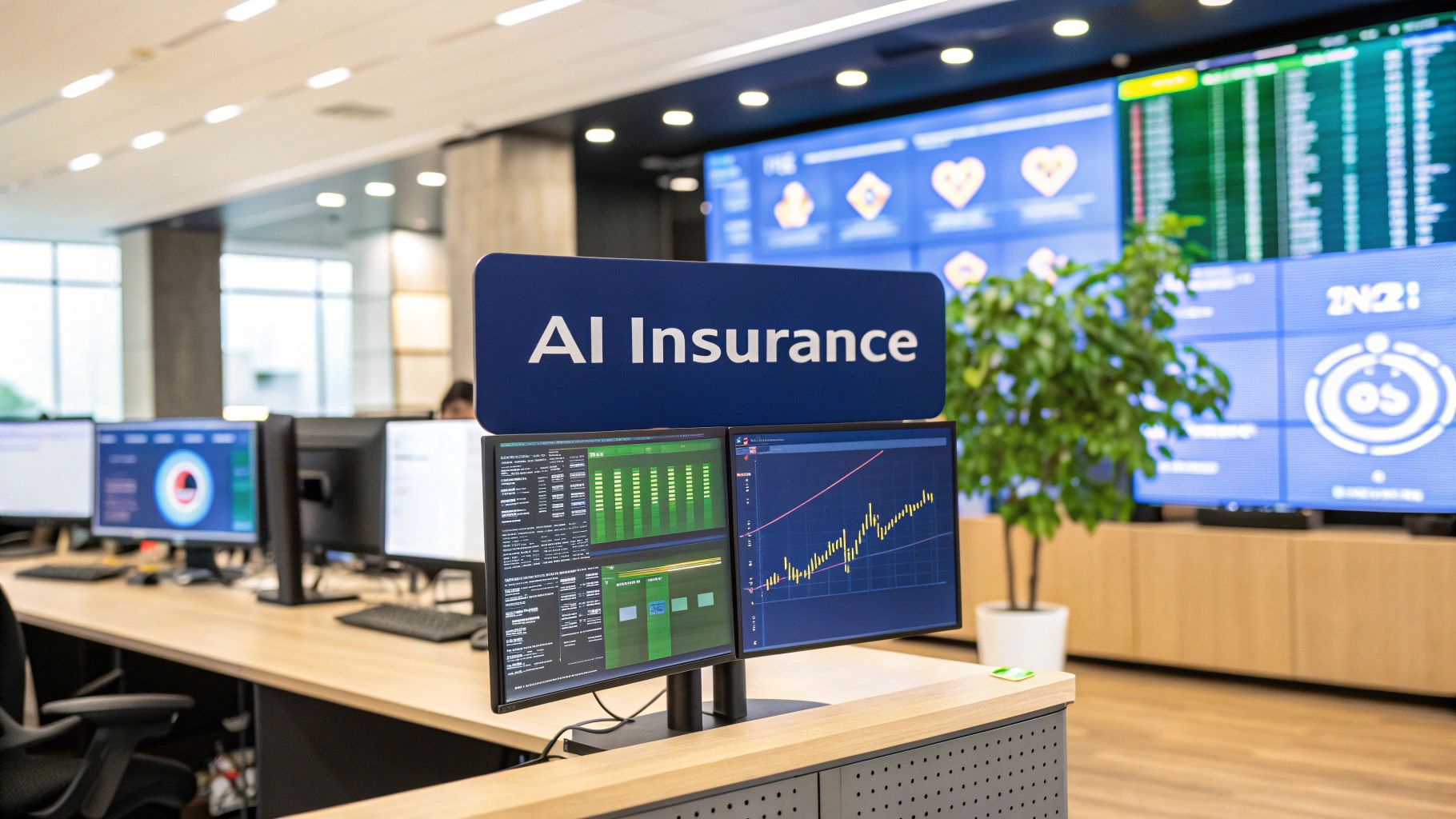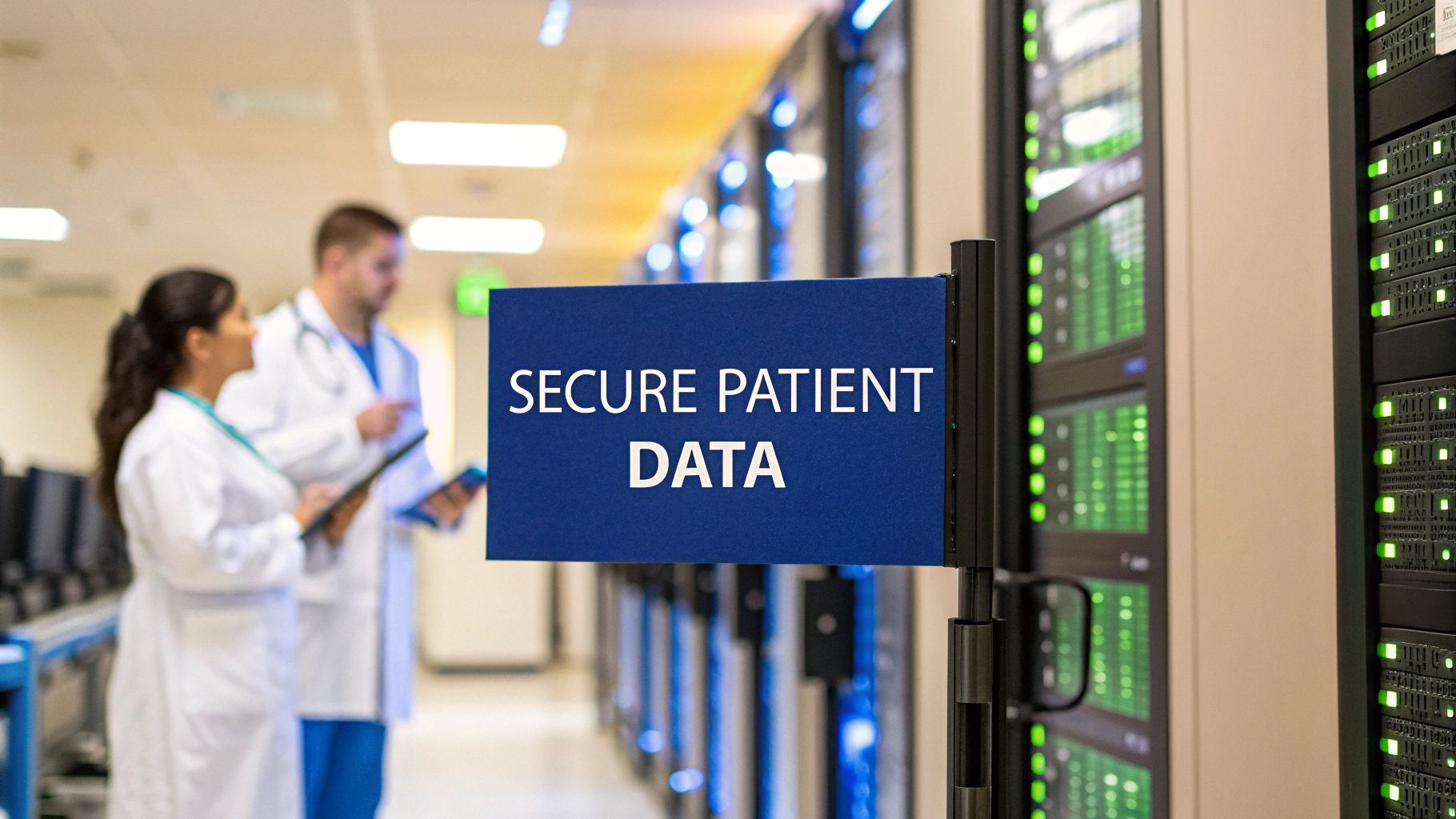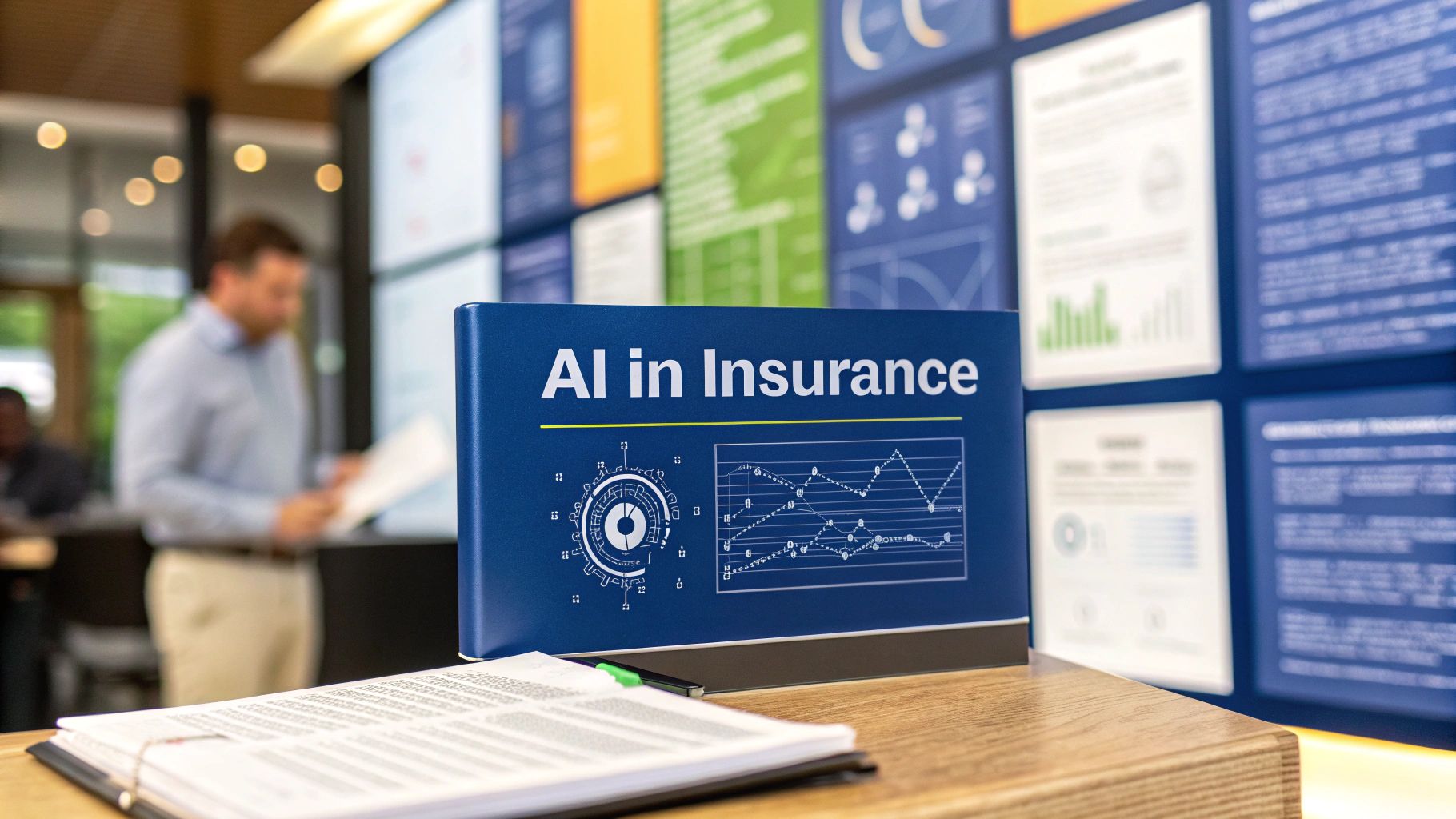Picture this: your healthcare isn't just about reacting to illness. Instead, it’s proactive, even predictive, shaped by your unique genetic code and lifestyle choices. This isn't science fiction; it's the new reality taking shape with AI-powered patient care.
Think of AI as a tireless, brilliant partner working alongside your doctor. It can sift through millions of data points in moments, spotting subtle patterns that might escape the human eye.
The New Reality of AI-Powered Patient Care
Artificial intelligence is changing the very fabric of how we diagnose, treat, and care for people. The point isn't to replace doctors, but to give them compelling tools for deeper insight. The goal is a healthcare system that runs more smoothly, is easier for everyone to access, and, perhaps surprisingly, feels more human.
By integrating AI, we're seeing huge improvements. Diagnostics are becoming more accurate, treatments are becoming more personalized, and the behind-the-scenes work that keeps hospitals running is becoming more efficient.
Consider this: family physicians often spend over 17 hours a week just on administrative tasks like paperwork and taking notes. That's more than two full workdays stolen from patient care. AI-powered tools are already chipping away at this burden, freeing up doctors to focus on what they do best: caring for you.
From Concept to Clinical Practice
At its core, the idea is to use powerful algorithms to make sense of health data on a scale no human ever could. This is how we move away from a "one-size-fits-all" approach to medicine and toward something proactive and built around the individual.
To see how different organizations are tackling this shift, you can delve deeper into healthcare artificial intelligence.
We're already seeing this technology make a real difference in several key areas:
-
Predictive Analytics: AI models can look at a patient's medical history, genetics, and lifestyle to flag potential health risks long before they become serious problems.
-
Medical Imaging: Specialized algorithms can analyze X-rays, CT scans, and MRIs to detect abnormalities like tumours, often faster and with greater precision than the naked eye.
-
Personalized Treatment Plans: For complex diseases like cancer, AI can analyze a patient's specific genetic data to help doctors design treatments that are tailored right down to the molecular level.
The real purpose of AI in healthcare is to enhance human expertise, not replace it. It’s a partnership where technology does the heavy lifting with data, allowing clinicians to focus on the compassionate, nuanced side of medicine that only a person can provide.
As we go on, we'll break down exactly how AI is leading to faster diagnoses, more effective treatments, and better-run hospitals. It’s quickly becoming an essential tool in the modern medical toolkit.
Why AI is a Game-Changer for Patient Outcomes
Bringing artificial intelligence into healthcare isn't just about adding new technology; it’s about fundamentally changing how we approach medicine. We're moving away from a system that reacts to illness and toward one that is proactive, predictive, and incredibly personal. The result is a level of precision and efficiency we’ve never seen before.
The impact is most visible in three key areas: getting diagnoses right the first time, crafting treatment plans for the individual instead of the masses, and clearing away the administrative clutter that bogs down our clinical experts.
Achieving Superior Diagnostic Accuracy
One of the most impressive roles for AI is in medical imaging. Think about a radiologist looking at a chest X-ray. Now, imagine an AI algorithm that has been trained on millions of scans, analysing that same image in seconds. It can spot subtle patterns and tiny abnormalities that the human eye, even a highly trained one, might miss.
This isn't about replacing doctors; it's about giving them super-powered tools. Early detection is often the single most important factor in a patient's recovery, and AI-powered patient care provides that critical head start. It's like having a second set of eyes on every scan; eyes that never get tired and have an almost limitless photographic memory.
To really see the difference AI makes, it's helpful to compare old and new methods side-by-side.
Traditional vs. AI-Powered Patient Care Approaches
|
Healthcare Function |
Traditional Approach |
AI-Powered Approach |
|---|---|---|
|
Diagnostics |
Relies on manual interpretation of scans and lab results by clinicians. |
AI algorithms analyse medical images and data to identify patterns and flag potential issues with high accuracy, often earlier than humanly possible. |
|
Treatment Planning |
Based on established clinical guidelines and the physician’s experience, often following a “one-size-fits-most” model. |
Predictive models analyse a patient’s unique genetic, lifestyle, and clinical data to recommend therapies with the highest probability of success. |
|
Patient Monitoring |
Periodic check-ups and manual review of vital signs. |
Continuous monitoring with wearable devices and AI-driven alerts that notify care teams of subtle changes in real-time. |
|
Administrative Tasks |
Physicians and staff spend significant time on manual data entry, charting, and scheduling. |
Automation of clinical documentation, smart task routing, and AI-assisted patient communication, freeing up clinicians to focus on care. |
This table shows a clear shift: AI injects data-driven precision and efficiency into every corner of the patient journey, supporting clinicians and improving outcomes.
Creating Truly Personalised Treatment Plans
Diagnostics is just the beginning. AI is also making it possible to design treatments that are tailored to an individual's unique biology. Instead of relying on broad protocols, predictive models can sift through a patient’s entire health profile, like genetics, lifestyle habits, and lab results, to pinpoint the therapy most likely to work for them.

This is a massive leap forward, especially for complex diseases. In cancer treatment, for instance, AI can match a patient to a specific clinical trial based on the genetic signature of their tumour. This kind of precision not only makes treatments more effective but can also reduce harsh side effects. To get a fuller picture, you can explore more about the benefits of AI in the healthcare industry.
Streamlining Clinical and Administrative Workflows
A huge, often underestimated, win for AI is its ability to slash the administrative burden. It’s a well-known secret that doctors can spend up to 40% of their day on paperwork and electronic health records, time that could be spent with patients.
AI-powered tools are taking on these repetitive jobs and doing them incredibly well.
-
Smarter Documentation: Imagine a doctor having a conversation with a patient while an AI system listens in, automatically generating accurate clinical notes. This alone can save hours every day.
-
Intelligent Tasking: These systems can figure out a patient's needs and automatically send tasks to the right person, whether it's a pharmacist, a nurse, or an administrator.
-
Faster Communication: AI can help draft clear, consistent answers to common patient questions, so care teams can respond much more quickly.
By automating the mundane, we give clinicians their time back. This allows them to focus on the human side of medicine, including listening, building trust, and providing compassionate care. It’s a win for the patient experience and a powerful tool against professional burnout.
Real-World Examples of AI in Clinical Practice
Let's move past the theory and look at how artificial intelligence is actually showing up in clinics and hospitals today. This isn't science fiction; it’s a powerful tool being used right now to solve genuine problems and improve the patient journey across a whole range of medical specialties.
One of the clearest and most established examples is in radiology. Think of AI algorithms as a radiologist's partner, trained on massive libraries of medical images. These tools can scan X-rays, CTs, and MRIs with incredible speed and precision, flagging subtle details that a human eye might miss on the first pass. This is a game-changer for early cancer detection, where finding a tumour in its earliest stages can make all the difference.

It's not just about spotting problems, either. These systems can help prioritize the workload, pushing the most critical scans to the top of the queue. This simple change helps streamline the workflow in a busy department and gets crucial results back to anxious patients that much faster.
Changing the Game in Oncology and Cardiology
In oncology, AI is fueling the shift toward precision medicine. Instead of a one-size-fits-all approach, oncologists can now use AI to analyze a patient’s specific genetic makeup and the unique molecular signature of their tumour. This allows them to create truly personalized treatment plans that go after cancer cells more effectively while sparing healthy tissue.
Cardiology is experiencing a similar leap forward. Predictive models are now digging into electronic health records (EHRs) to identify patients who are at high risk for events like a heart attack or stroke, often before they show any obvious symptoms.
-
Spotting Risk: By analyzing years of data, such as lab results, vital signs, and lifestyle factors, AI can pick up on subtle patterns that point to a higher risk.
-
Getting Ahead: This allows cardiologists to step in with preventative care, like recommending lifestyle changes or starting a medication, before a crisis happens.
-
Constant Watch: AI-powered wearables can also monitor heart rhythms around the clock, alerting care teams to issues like atrial fibrillation as they occur.
This move from reactive to proactive care is exactly what modern medicine is striving for. It gives clinicians the ability to anticipate problems instead of just cleaning up after them. For a deeper dive into how specific tools are helping, you can explore topics like AI in Healthcare: How Chatbots Can Help Your Team.
Expanding into Mental Health and Beyond
AI's reach now extends well beyond physical health. In mental health, AI-driven apps are opening up new ways to offer support and monitor a person's well-being. These tools can analyze "digital biomarkers", things like speech patterns, typing speed, or even social media activity, to notice subtle shifts in mood or mental state. It's a non-intrusive way to keep an eye on things between therapy appointments.
The adoption of these technologies is picking up speed. A 2025 American Medical Association survey found that about 66% of physicians in California were using AI tools in their practice. That's a huge jump from just 38% in 2023, showing just how quickly these tools are becoming a standard part of the patient care toolkit.
Each of these examples tells a story of a real problem being solved. AI is not just an abstract idea; it is a practical tool that helps doctors diagnose earlier, treat more effectively, and provide more attentive care to their patients.
These different applications really highlight how versatile AI can be. Whether it's finding a tiny nodule on a lung scan, predicting a heart condition, or offering a new avenue of support for mental wellness, the technology is making a real, measurable impact. The goal is always the same: to enhance human expertise, creating a partnership where technology and clinicians work together for better patient outcomes.
Navigating the Hurdles of AI Implementation
Bringing artificial intelligence into a healthcare setting isn't as simple as installing new software. It's a massive undertaking that brings a host of complex challenges and ethical questions to the forefront, all of which demand careful, deliberate planning. To do it right, you have to confront these hurdles head-on, from safeguarding highly sensitive patient data to making sure the technology actually closes gaps in care, rather than making them wider.
The journey requires a clear-eyed view of the risks. While the potential for improving patient care is enormous, the path is littered with complexities that can sink even the most well-intentioned projects if they aren't managed properly.
Protecting Patient Data and Ensuring Compliance
Data privacy is, without a doubt, the biggest concern. AI systems in healthcare run on huge volumes of patient information, which makes rock-solid security and compliance completely non-negotiable. Any solution has to be built from the ground up to meet strict regulations like the Health Insurance Portability and Accountability Act (HIPAA), which dictates exactly how protected health information must be managed.
This goes way beyond standard security measures. It means having a deep, practical understanding of data governance, including:
-
Robust Encryption: All patient data must be encrypted, both when it's sitting on a server (at rest) and when it's being sent from one place to another (in transit).
-
Data Anonymization: Before data is used to train AI models, it needs to be stripped of any personal identifiers. This is fundamental to protecting patient confidentiality.
-
Access Controls: Strict rules must be in place to ensure that only authorized personnel can get anywhere near sensitive information.
Getting this wrong doesn't just open you up to crippling legal and financial penalties; it destroys the single most important asset in healthcare: patient trust. To get a better handle on these complexities, our guide on developing custom medical software offers some valuable insights.
Confronting Algorithmic Bias and the Black Box Problem
Another major hurdle is the very real risk of algorithmic bias. An AI model is only as good as the data you feed it. If that data isn't diverse and truly representative of the entire patient population, the AI can inadvertently learn and even magnify existing societal biases. The result? You could end up with a diagnostic tool that's less accurate for certain demographic groups, making health inequities even worse.
The 'black box' problem presents a unique challenge in clinical settings. This occurs when an AI model reaches a conclusion, but its internal decision-making process is so complex that even its developers cannot fully explain how it arrived at that specific answer.
This lack of transparency kicks open a hornet's nest of accountability questions. If an AI makes a mistake in a diagnosis or a treatment recommendation, who's responsible? Is it the doctor who followed the suggestion, the hospital that bought the system, or the developers who built it? Figuring out clear lines of accountability is absolutely essential for building trust with medical professionals and keeping patients safe.
The Necessity of Expert Partnership
Getting over these obstacles is not a DIY project. It requires specialized expertise. Simply buying an off-the-shelf AI tool isn’t a strategy. A successful rollout requires a thoughtful plan that tackles data security, ethics, and clinical workflow integration right from the start.
This is exactly why finding an experienced partner is so important. A skilled team can help you navigate the confusing regulatory maze, design systems that are fair and explainable, and make sure the technology genuinely helps your clinicians instead of adding to their workload. By taking a responsible and measured approach, healthcare organizations can finally unlock the incredible benefits of AI while protecting patients and building a fairer system of care for everyone.
How Regulations are Shaping Medical AI
When it comes to using AI in medicine, a solid legal framework is the very foundation of trust. As these powerful tools weave their way into our clinics and hospitals, clear rules of the road are what make responsible innovation possible. This evolving regulatory landscape gives both patients and providers the confidence they need to move forward.
Without these guardrails, even the most promising AI technologies would struggle to gain traction. Regulations ensure that every system is built and used with patient safety, data privacy, and ethical principles at the forefront. Think of it as building a strong, reliable bridge; you need a solid engineering plan before you let traffic cross.

Pioneering Governance in Healthcare AI
Around the world, and right here at home, governments are starting to draft specific legislation for medical AI. California, for example, is leading the charge, putting laws in place that set a high bar for patient protection and transparency. These rules often go beyond federal mandates, showing what's possible when you balance AI's potential with a serious commitment to accountability.
A prime example is a new law taking effect in 2025. It requires healthcare organizations to tell patients if generative AI was used in their clinical communications, unless a human provider has already reviewed and signed off on it. It’s a commonsense approach that ensures technology supports clinical decisions, rather than making them on its own.
Key Regulatory Focus Areas
As lawmakers and health authorities try to keep up with the pace of technology, a few central themes keep coming up. These are the areas where they're concentrating their efforts to protect patients while still encouraging medical AI to advance.
You'll see three main areas of concern in most new regulations:
-
Transparency Requirements: This is all about making sure patients know when AI has played a role in their diagnosis or treatment. It’s a simple but crucial step toward ensuring patients are fully informed about their care.
-
Human Oversight: This is a big one. It means a qualified medical professional must review and validate AI-generated insights, especially when the stakes are high. It keeps clinical judgment right where it belongs, at the centre of patient care.
-
Data Security and Privacy: AI models need data, but that data is incredibly sensitive. These rules enforce strict compliance with privacy laws to make sure patient information is always protected.
At the end of the day, these regulations aren't about holding technology back. They're about creating a safe, trustworthy environment where AI can genuinely improve patient outcomes for everyone.
Getting a handle on these rules can feel complicated, which is why having the right partners is so important. You need expertise in both the technology and the legal landscape to get it right. For a closer look at the principles behind these rules, you can learn more about ethics and AI in healthcare in our detailed article. It’s essential reading for anyone serious about responsible implementation.
Medicine's Next Chapter: A Human-AI Partnership
The future of healthcare isn't about replacing doctors with algorithms. Instead, we're seeing the rise of a powerful partnership where artificial intelligence acts as an indispensable partner to clinicians, allowing them to do what they do best: care for people. We’re shifting away from a system that just reacts to sickness and moving toward one that is truly predictive, preventative, and deeply personal.
Think about what a routine check-up could look like. It's no longer a one-size-fits-all approach. With AI, your doctor can draw on your unique genetic code to recommend treatments and lifestyle adjustments made just for you. This is proactive health in action, getting ahead of problems before they start.
New Frontiers in Clinical AI
This isn't just about tweaking existing processes; we're on the verge of some breakthroughs that will completely reshape how doctors work and how medical discoveries are made. These aren't far-off concepts from a science fiction movie; they're being actively developed right now.
Two of the most exciting areas are:
-
AI-Driven Drug Discovery: Finding a new drug can take a decade and cost billions. AI is changing that game entirely. By sifting through enormous biological datasets, algorithms can pinpoint promising compounds and predict how they'll work, potentially slashing development time in half.
-
Ambient Clinical Intelligence: Imagine a doctor's visit where the physician can focus entirely on you, not a computer screen. This technology listens to the natural conversation and automatically generates the clinical notes. It frees doctors from administrative overload, allowing them to reconnect with the human side of medicine.
The goal here is simple: let technology manage the overwhelming data so clinicians can focus on their patients. It’s about enhancing human skill, not making it obsolete.
This vision is both ambitious and incredibly practical. It directly tackles real-world challenges like physician burnout and long waits for diagnoses. By fostering a true collaboration between human expertise and machine intelligence, we can create a healthcare system that works better for everyone. The groundwork for this new era of AI-powered patient care is being laid today.
We are dedicated to building this future, using our experience to create solutions that make a real impact. To get to know the people driving this work and our passion for innovation, you can learn more about our team and mission.
Your Questions About AI in Patient Care, Answered
It's completely normal to have questions about how AI is changing medicine. Both patients and healthcare professionals are curious about what this all means. Let's tackle some of the most common concerns head-on with clear, straightforward answers to help you feel more comfortable with the future of AI-powered patient care.
This new frontier in health is something we need to talk about openly. Getting a handle on these key points is a great first step for anyone involved in the healthcare journey.
Will AI Replace My Doctor?
Not a chance. The real purpose of AI in healthcare isn't to replace doctors, but to empower them. Think of AI as an incredibly smart assistant, one that can sift through massive amounts of data or handle time-consuming paperwork in the blink of an eye.
This frees up doctors and nurses to focus on what truly matters: you. It gives them more time for the human side of medicine: critical thinking, building a trusting relationship with you, and offering the kind of compassionate care a machine can't provide. The best path forward is one where human expertise and technology work together.
How Is My Personal Health Data Kept Safe?
Patient privacy is non-negotiable, and that doesn't change with AI. Any AI system used in a Canadian clinic or hospital must follow strict privacy laws like PIPEDA, ensuring your information remains confidential and secure.
This is done with several layers of robust security built right into the system:
-
End-to-end data encryption scrambles your information, making it unreadable to anyone without authorization.
-
Data anonymization strips out personal details like your name or address before the data is used to train an AI model.
-
Federated learning is a clever technique that allows AI to learn from data on a hospital's own secure servers, without the data ever having to leave the building.
These safeguards are fundamental to any ethical AI development services, designed from the very beginning to protect your privacy.
Can AI in Healthcare Be Biased?
Yes, it can be, and this is one of the most important challenges we need to solve. An AI is only as good as the data it learns from. If the training data doesn't reflect the diversity of our population, the AI can end up making biased decisions that worsen existing health inequities. For example, a diagnostic tool trained mostly on data from men might be less accurate for women.
Tackling algorithmic bias is a cornerstone of responsible AI development. The solution involves a constant effort: using diverse and representative data, rigorously testing for fairness across different patient groups, and continuously monitoring the system to find and fix biases that pop up.
Creating fair and equitable systems is the primary goal of ethical artificial intelligence development services. As we explored in our AI-powered patient care adoption guide, building this trust is essential. The team at Cleffex is passionate about pioneering these ethical solutions. You can learn more about our values on our about us page.
At Cleffex Digital Ltd, we're committed to building innovative, secure, and ethical AI solutions that solve real-world challenges in healthcare. If you're ready to explore how AI can empower your organization, visit us today.
